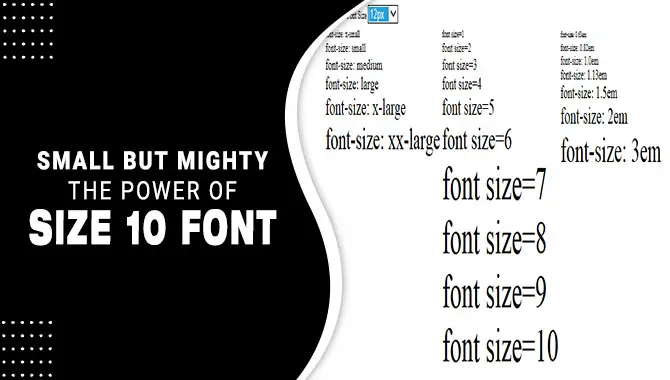Small but mighty fonts like Arial Narrow, Calibri Light, or Verdana are compact and impactful. They can help fit more text into a limited space and highlight key information.
However, it’s essential to avoid using too small fonts as they can compromise legibility. Have you ever wondered why some websites are more appealing to the eye than others? The answer might lie in the font size they use. One such font that has recently gained popularity is the size 10 font.
As the name suggests, it is a small but mighty font with the power to make a big difference in your website’s design. Here we will explore what size 10 font is, its impact on desktop and mobile devices, and how you can use it effectively in your website’s templates. We will also discuss why this small but mighty font is so powerful and provide tips on incorporating it into your website’s design for maximum impact.

The Importance Of Font Size 10 Font In Design
Size 10 font is a small but readable font commonly used for body text in printed materials. It measures 3.5 mm or 0.138 inches in height and may not be suitable for those with visual impairments. Consider your content’s purpose and audience when selecting font size.
When designing any content, the choice of font size plays a significant role in determining its success. It impacts both the readability and user experience of your content. The right font size can help set the tone and personality of your website while guiding users to essential information effectively
In fact, using smaller fonts like Arial Narrow or Calibri Light can give your layout a sophisticated touch. At the same time, maintaining proper font hierarchy is key to ensuring that your content remains legible throughout.
While choosing font sizes for your website or printed materials, it’s crucial to keep accessibility in mind. Larger fonts may be necessary for some individuals with visual impairments. You may also want to consider using different fonts for headings and body text and experimenting with spacing between lines and paragraphs for optimal readability.
Overall, selecting the right font size should be essential when crafting online or offline content. So whether you’re working on privacy policies or need help typesetting your website, always remember that typography matters.
The Impact Of Size 10 Font On Desktop
On desktop devices, the font size is crucial in determining how easily readable the content would be for users. Although size 10 font may appear small at first glance, it can increase legibility significantly when complemented by other typography techniques like spacing and different fonts such as Arial or Times New Roman.
As designers and developers, we must remember that proper font size hierarchy can help guide the user’s attention to important information. Additionally, we should always consider accessibility when choosing font sizes since larger fonts might be necessary for visually impaired users. Considering these factors while designing desktop device content could ensure better accessibility and user experience.
The Impact Of Size 10 Font On Mobile
Choosing the perfect font size for mobile devices is significant as this aspect makes reading texts comfortable. Although typically disregarded for being small-sized and insignificant in desktop designs, Size 10 fonts are advantageous and can make a substantial impact if chosen wisely while designing for mobile devices.
The smaller size of these fonts allows for displaying more content without affecting its legibility or readability. A well-balanced and organized layout improves the overall User Experience (UX). Proper spacing and suitable contrast will enhance the impact of your typographic selections further.
The importance of balance between various design aspects while using different fonts cannot be overstated. One must consider factors like line length, paragraph formatting, typography choices like typeface selection (such as Arial or Times New Roman), point sizes (measured by pt or em or px), different types of fonts available and their respective benefits (like Italics), default sizes set by browsers or PDF viewers using metal type units like mm among others.
Incorporating suitable templates in your designs can be beneficial, too, as it provides a coherent structure that enhances your message’s legibility. So why not incorporate Size 10 fonts in your next mobile design project?
Using Size 10 Font In Templates
When designing templates, using a size 10 font can be an excellent way to present more information while keeping it organized. By decreasing the font size, you can include more content without making it seem cluttered or overwhelming for readers.
Always balance smaller fonts with other design elements like proper spacing or contrasting colours to ensure readability. Choosing the right typeface is also crucial; Arial or Times New Roman are popular for their simplicity, legibility, and classic look.
With this knowledge, you can create visually appealing templates that are easy to read while conveying vital information effectively. Don’t be afraid to experiment with different font sizes until you find what works best for your brand’s needs.
Common Uses For Size 10 Font
Size 10 font is popular for various uses, from creating professional documents to designing eye-catching graphics. In business, size 10 font is commonly handy for legal documents, contracts, and other official correspondence. It is also a popular choice for resumes and cover letters, as it allows much text to be packed into a small area without sacrificing readability.
Regarding graphic design, size 10 font can be handy for captions, labels, and other supporting text that needs to be legible but not overpowering. It can also be combined with larger fonts to create unique typography effects that stand out. Overall, size 10 font is a versatile option that offers practicality and creativity in various applications.
Tips For Designing Effective Documents With Size 10 Font
When designing documents with size 10 font, there are a few tips to remember to ensure they are effective and easy to read. Firstly, choosing a legible font that is easy on the eyes, such as Arial or Times New Roman is important. Secondly, use bold text or headings to help guide the reader through the document and make important information stand out.
Thirdly, limit the amount of text on each page and break up large blocks of text with bullet points or numbered lists. This will help prevent the reader from becoming overwhelmed or disengaged. Lastly, use plenty of white space throughout the document to create a clean, uncluttered look. By following these tips, you can design documents with size 10 font that are visually appealing and easy to read.
Conclusion
Designing effective documents with size 10 font can be a challenging task. Size 10 is a small but mighty font that can save you space, improve readability and make your content more visually appealing. It is an excellent choice for web design because it looks great on both desktop and mobile devices.
Using size 10 font in templates can also help you create a consistent and professional-looking website. The power of size 10 font lies in its ability to communicate information clearly and succinctly while still visually appealing. To use size 10 font effectively on your website, choose a legible typeface, adjust line spacing, and use it consistently throughout your site.
Frequently Asked Questions
What Is Size 10 Font?
Size 10 is a small and standard font often used in professional documents. However, it may pose readability challenges for individuals with visual impairments. Choosing appropriate fonts based on the document type and audience is crucial. Size 10 font measures 3.5 mm or 0.14 inches in height.
Is Size 10 Font Small?
In general, a size 10 font is considered small. However, it is commonly handy for footnotes or captions. For body text, a larger font size, such as 12 or 14, is recommended for better readability. The appropriate font size may also vary based on the medium and audience of the text.
Is Size 10 Font Readable?
Although size 10 font is generally readable, it may not be the most comfortable for all readers. The recommended font size for body text is 10-12 points, but factors like font type and line spacing can also impact readability. When choosing a font size, consider your audience’s reading preferences.
Is Font Size 10 Too Small For A Book?
While font size 10 is widely used in books and is generally acceptable, readability depends on factors like the typeface and line spacing. Consider the target audience and their preferences when deciding on a font size that complements the book’s content and layout.
What’s The Best Font Size?
The optimal font size varies depending on the document’s intention and intended readership. A font size between 10-12 points for the body text is typically suitable, while headings and subheadings may necessitate larger sizes for emphasis. When choosing a font size, legibility and readability are crucial considerations.

David Egee, the visionary Founder of FontSaga, is renowned for his font expertise and mentorship in online communities. With over 12 years of formal font review experience and study of 400+ fonts, David blends reviews with educational content and scripting skills. Armed with a Bachelor’s Degree in Graphic Design and a Master’s in Typography and Type Design from California State University, David’s journey from freelance lettering artist to font Specialist and then the FontSaga’s inception reflects his commitment to typography excellence.
In the context of font reviews, David specializes in creative typography for logo design and lettering. He aims to provide a diverse range of content and resources to cater to a broad audience. His passion for typography shines through in every aspect of FontSaga, inspiring creativity and fostering a deeper appreciation for the art of lettering and calligraphy.

